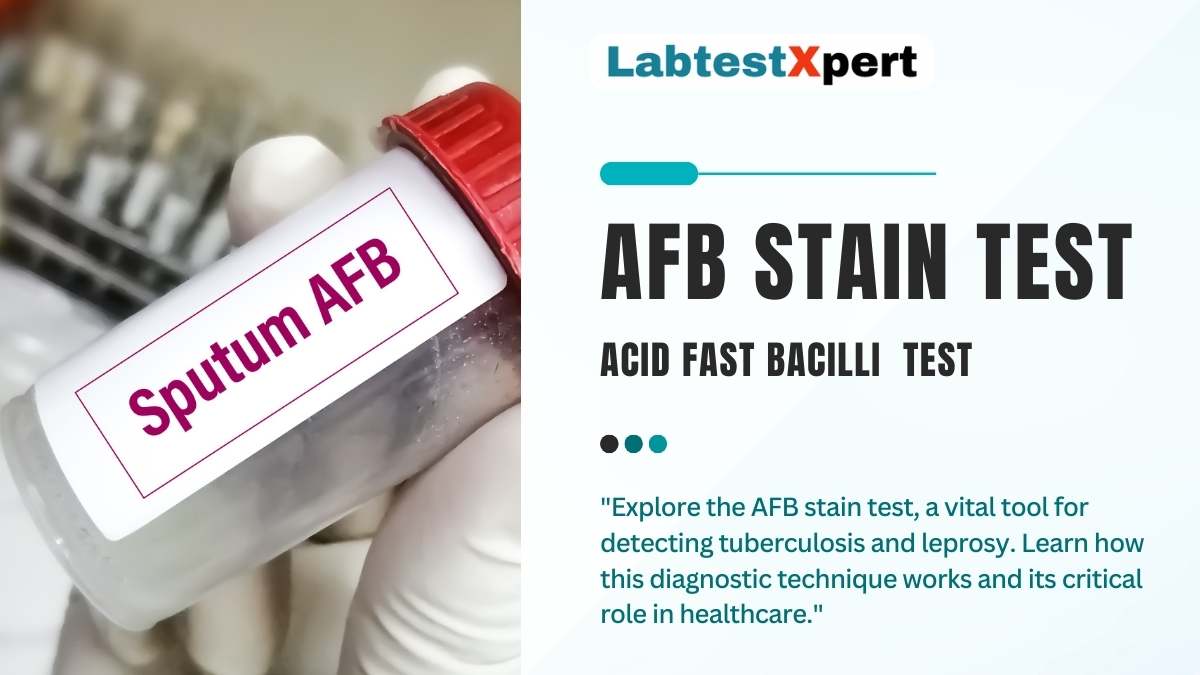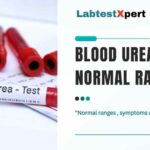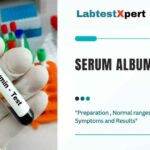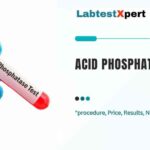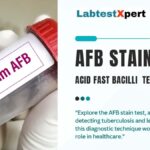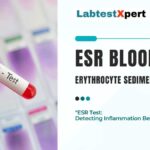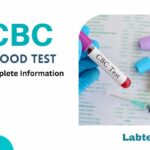The AFB stain test (acid fast bacilli) is a laboratory technique used to detect the presence of acid-fast bacteria in clinical samples. It is a crucial tool in the diagnosis of mycobacterial infections, such as tuberculosis and leprosy. Below, you’ll find detailed and information about the AFB stain test
What is the AFB stain Test (acid fast bacilli) ?
The AFB stain test is a lab method for finding acid-fast bacteria in a patient’s sample. Acid-fast bacteria are a group of bacteria that are resistant to the decolorization step in the staining process due to their unique cell wall composition, which contains a high content of mycolic acids. This resistance to decolorization allows them to retain the primary stain (usually carbol fuchsin) and appear “acid-fast” when viewed under a microscope.
The AFB stain test is commonly used to diagnose and identify Mycobacterium species, including Mycobacterium tuberculosis, the bacterium responsible for tuberculosis, and Mycobacterium leprae, which causes leprosy. These bacteria are notoriously difficult to stain using traditional staining methods because of their waxy cell walls.
Why Is It Essential?
The AFB (acid-fast bacilli) stain test is essential for several reasons:
- Diagnosis of Tuberculosis (TB):
The AFB stain test is a primary method for diagnosing tuberculosis, a highly contagious and potentially life-threatening disease caused by Mycobacterium tuberculosis. Early diagnosis is crucial for effective treatment and preventing the spread of the disease.
- Leprosy Diagnosis:
It is also used in the diagnosis of leprosy, caused by Mycobacterium leprae. Leprosy is a chronic infectious disease that, if left untreated, can lead to severe disability and disfigurement.
- Rapid Results:
The AFB stain test provides relatively rapid results, making it an important tool in identifying potential cases of mycobacterial infections. Quick diagnosis can lead to timely treatment and reduced transmission.
- Cost-Effective Screening:
It serves as a cost-effective and efficient initial screening tool. While more sophisticated tests like PCR (polymerase chain reaction) and cultures are used for confirmation, the AFB stain test can quickly identify potential cases for further investigation.
- Control of Infectious Diseases:
By facilitating the early diagnosis of mycobacterial infections, the AFB stain test plays a vital role in controlling and managing the spread of diseases like tuberculosis. Timely treatment can prevent the development of drug-resistant strains.
- Public Health:
The test is a cornerstone of public health efforts to track and manage infectious diseases. It helps health authorities identify and isolate individuals with active infections, reducing the risk of transmission within communities.
- Treatment Decisions:
A positive AFB stain result guides healthcare providers in determining the appropriate treatment regimen. The choice of antibiotics and the duration of treatment may differ depending on the specific mycobacterial species and its susceptibility.
- Monitoring Treatment Progress:
The AFB stain test is used to monitor the effectiveness of treatment. Changes in AFB stain results over time can indicate whether the treatment is successful in reducing the bacterial load.
Alternate name of the test?
The AFB stain full form is known as acid-fast bacilli stain test and sometimes referred to by alternate names or related terms, including:
- Ziehl-Neelsen Stain ( ZN Stain ):
The Ziehl-Neelsen stain is a specific type of AFB staining technique. It’s named after its developers, Franz Ziehl and Friedrich Neelsen. This staining method uses carbol fuchsin as the primary stain.
- AFB Smear:
AFB smear is a colloquial term used to refer to the AFB stain test because it involves preparing a microscopic smear of the clinical sample on a glass slide.
- Tuberculosis Stain:
In clinical settings, especially when diagnosing tuberculosis, healthcare professionals may simply refer to the AFB stain test as the “tuberculosis stain” because it is primarily used for diagnosing this disease.
- Mycolic Acid Stain:
Acid-fast bacteria retain the stain due to the high content of mycolic acids in their cell walls. Therefore, the AFB stain test can be indirectly referred to as a “mycolic acid stain.”
Specimen Required for AFB stain tests ?
The specimen required for AFB (acid-fast bacilli) stain tests typically depends on the suspected mycobacterial infection and the part of the body being examined. Common specimens collected for AFB stain tests include:
- Sputum:
Sputum, or phlegm, is one of the most common specimens for AFB staining, especially for diagnosing pulmonary tuberculosis. Patients are often asked to produce a sputum sample through deep coughing.
- Bronchial Washings:
In cases where sputum is not available or insufficient, bronchial washings collected through bronchoscopy may be used for AFB staining.
- Cerebrospinal Fluid (CSF):
For diagnosing tuberculous meningitis, CSF is examined for the presence of acid-fast bacilli. This is usually done when there is suspicion of central nervous system involvement.
- Tissue Biopsies:
AFB staining can be performed on tissue samples obtained through biopsies of various organs, such as lymph nodes, skin lesions, or the gastrointestinal tract.
- Urine:
In some cases, urine samples may be collected, particularly when extra pulmonary mycobacterial infections are suspected.
- Gastric Aspirate:
For children who cannot produce sputum, gastric aspirate samples can be collected by aspirating stomach contents. This is often used for diagnosing pediatric cases of tuberculosis.
- Other Body Fluids:
AFB staining can be performed on other body fluids, such as pleural fluid (fluid around the lungs) or peritoneal fluid (fluid in the abdominal cavity), when infections are suspected in these areas.
- Semen:
Rarely, AFB staining may be used in cases of genitourinary tuberculosis, where semen samples may be collected.
The choice of specimen depends on the clinical presentation of the patient and the specific mycobacterial infection that is suspected. The type of specimen collected is critical in obtaining an accurate diagnosis and determining the appropriate course of treatment.
Method used for AFB stain test
The AFB (acid-fast bacilli) stain test typically employs the Ziehl-Neelsen staining (ZN stain) method, which is also known as the acid-fast staining technique. This method is specifically designed to detect acid-fast bacteria, such as Mycobacterium tuberculosis and Mycobacterium leprae, which have a unique cell wall composition that makes them resistant to traditional staining procedures. The Ziehl-Neelsen staining method uses specific dyes and a heat fixation step to identify acid-fast
AFB staining (acid fast bacilli) Procedure:
The AFB stain test involves the following steps:
- Safety Precautions:
Ensure that the laboratory personnel follow standard safety protocols, including wearing appropriate personal protective equipment (PPE) such as lab coats, gloves, and eyewear.
- Specimen Collection:
Collect the clinical specimen (e.g., sputum, tissue biopsy, cerebrospinal fluid) from the patient, ensuring proper specimen labelling and handling to maintain specimen integrity.
- Specimen Preparation:
- Prepare a smear: Spread a small amount of the clinical specimen onto a clean glass microscope slide, creating a thin, even smear.
- Heat fixation: Gently heat-fix the smear, typically by passing it through the flame of a Bunsen burner a few times. This heat fixation process helps adhere the bacteria to the slide.
- Staining:
- Flood the smear with carbol fuchsin, the primary stain, ensuring complete coverage of the specimen.
- Heat the slide by gently passing it through the flame (using a tripod or slide heater) until it steams (do not overheat). Maintain the slide at a temperature just below boiling for approximately 5 minutes.
- Flush the slide with tap water to eliminate any surplus stain
- Decolorization: Flood the slide with acid-alcohol (acidified ethanol) for about 15-20 seconds to remove the primary stain from non-acid-fast bacteria. The decolorization step is a critical part of the staining process.
- Rinse the slide with tap water.
- Counterstain: Apply a contrasting color, such as methylene blue or brilliant green, to the smear and allow it to stand for 1-2 minutes.
- Rinse the slide with tap water to remove excess counterstain.
- Microscopic Examination:
- Place the stained slide under a light microscope, using oil immersion for high magnification.
- Examine the stained smear using a 100x (oil immersion) objective lens. Look for the characteristic red or pink acid-fast bacteria (e.g., Mycobacterium) and blue or green non-acid-fast bacteria.
- Record your observations and interpretations.
- Quality Control:
- Regularly monitor and maintain the quality of staining reagents and procedures.
- Use control slides with known acid-fast bacteria to validate the staining process.
- Reporting:
- Report the results, indicating whether acid-fast bacteria are present (positive) or absent (negative). Include any semi-quantitative assessment if applicable (e.g., “Scanty,” “1+,” “2+,” “3+,” “4+”).
- Documentation:
Document all details of the test, including specimen information, staining procedures, microscopic observations, and any quality control measures.
- Follow-Up Testing:
A positive result may require follow-up testing, such as culture and molecular testing, for species identification and drug susceptibility testing.
AFB (acid-fast bacilli) stain test price:
The cost of an AFB (acid-fast bacilli) stain test in India can vary depending on several factors, including the location (state or city), the healthcare facility or laboratory where the test is conducted.
Government Hospitals/Clinics:
AFB stain tests price are often more affordable and May cost between Rs. 50 to Rs. 200 or even less.
Private Laboratories/Clinics:
The cost in private labs can vary widely. On average, you might expect to pay between Rs. 200 to Rs. 600 for an AFB stain test.
You may need a AFB stain test if you have symptoms such as:
You may need an AFB (acid-fast bacilli) stain test if you have symptoms that are suggestive of mycobacterial infections, particularly tuberculosis (TB) or leprosy. Common symptoms that might prompt a healthcare provider to order an AFB stain test include:
symptoms For Tuberculosis (TB):
- Persistent Cough:
- Fever:
- Night Sweats:
- Unexplained Weight Loss:
- Chest Pain:
- Fatigue and Weakness:
- Loss of Appetite:
- Breathing Difficulties:
Symptoms for Leprosy:
Leprosy symptoms can vary widely, but some common signs that may prompt an AFB stain test include:
- Skin Lesions:
- Numbness and Weakness:
- Muscle Weakness:
- Thickened Nerves:
It’s important to note that these symptoms are not specific to TB or leprosy and can be caused by various other medical conditions. The AFB stain test is used to confirm the presence of acid-fast bacteria and guide further diagnostic and treatment decisions.
AFB test (acid-fast bacilli) results mean:
The interpretation of the results of an AFB (acid-fast bacilli) stain test depends on whether the test is positive or negative. Here’s what the results typically mean:
- AFB test Positive Result:
- Presence of Acid-Fast Bacteria: A positive result indicates the presence of acid-fast bacteria in the clinical specimen. This staining pattern suggests the possible existence of mycobacterial infections, such as tuberculosis (TB) or leprosy.
- Further Testing Required: While a positive result strongly suggests a mycobacterial infection, the AFB stain test is not definitive for species identification. Therefore, additional testing, such as culture or molecular tests, is typically performed to confirm the specific mycobacterial species and assess drug susceptibility.
- Treatment Initiation: In clinical practice, a positive AFB stain result often prompts healthcare providers to initiate treatment for the suspected mycobacterial infection while awaiting confirmation through further testing. This is particularly important in TB cases to prevent the spread of the disease.
- AFB test Negative Result:
- Absence of Acid-Fast Bacteria: A negative result suggests the absence of acid-fast bacteria in the clinical specimen. However, it’s important to note that a negative result does not definitively rule out a mycobacterial infection.
- Limitations: There are several factors that can lead to a false-negative result, including a low concentration of bacteria in the sample, the presence of non-replicating or dormant bacteria, or poor specimen quality.
- Clinical Correlation: Clinical and radiological findings, along with a patient’s symptoms and risk factors, are taken into consideration when interpreting a negative result. If clinical suspicion remains high, further testing or follow-up may be recommended.
In summary, the AFB stain test is an initial screening tool that provides qualitative results. A positive result strongly suggests the presence of acid-fast bacteria and prompts further diagnostic and treatment steps. A negative result, while reassuring, does not conclusively rule out a mycobacterial infection, and clinical judgment, along with additional testing, is important for a comprehensive evaluation.
Benefits of AFB stain test :
The AFB (acid-fast bacilli) stain test offers several benefits in the diagnosis and management of mycobacterial infections, particularly tuberculosis (TB) and leprosy, as well as other conditions caused by acid-fast bacteria. Some of the key benefits of the AFB stain test include:
- Early Diagnosis:
The AFB stain test allows for the early detection of mycobacterial infections, especially TB and leprosy. Early diagnosis is crucial for initiating treatment promptly, which can lead to better outcomes and reduced disease transmission.
- Rapid Results:
AFB staining provides relatively quick results, typically within hours, making it a valuable tool for healthcare providers to begin treatment and infection control measures promptly.
- Screening Tool:
The test serves as an effective screening tool, especially in regions with a high prevalence of TB. It helps identify individuals who may require further diagnostic evaluation and treatment.
- Resource Efficiency:
AFB staining is a cost-effective initial diagnostic tool, which is particularly important in resource-constrained healthcare settings.
- Initiating Treatment:
Positive AFB stain results often prompt healthcare providers to initiate treatment for mycobacterial infections while waiting for confirmation through more specific tests. This “treat-first” approach can save lives and prevent the spread of disease.
- Monitoring Treatment:
The test is used to monitor the effectiveness of TB treatment by assessing changes in the quantity of acid-fast bacteria over time. This helps healthcare providers gauge treatment progress and adjust treatment plans as needed.
- Public Health Surveillance:
AFB staining is used in public health programs to track the prevalence of mycobacterial infections, allowing health authorities to monitor disease patterns and take appropriate measures for disease control.
- Classification of Leprosy:
In the case of leprosy, the AFB stain test can aid in classifying the type of leprosy based on the bacterial load in samples. This informs the choice of treatment regimen.
- Pediatric Diagnosis:
AFB staining is used for paediatric TB diagnosis when children may have difficulty producing sputum. Gastric aspirates are collected and examined using the AFB stain test.
- Research and Epidemiology:
AFB staining is valuable for research studies and epidemiological investigations, helping scientists and healthcare experts understand the prevalence and transmission of mycobacterial infections.
In summary, the AFB stain test plays a crucial role in the early detection, diagnosis, and management of mycobacterial infections, particularly tuberculosis and leprosy.
Reliable sources for researching AFB stain test:
When researching the AFB stain test or related topics, it’s important to rely on reputable and authoritative sources. Here is a list of reliable sources you can consider for in-depth information and research:
- Centres for Disease Control and Prevention (CDC):
- Website: https://www.cdc.gov/
- The CDC provides a wealth of information on tuberculosis and diagnostic methods, including the AFB stain test.
- World Health Organization (WHO):
- Website: https://www.who.int/
- The WHO offers comprehensive resources on tuberculosis and its diagnosis, including guidelines and reports.
- Medical Journals:
- You can find scholarly articles and research papers related to the AFB stain test in medical journals like The American Journal of Clinical Pathology, Clinical Microbiology Reviews, and the Journal of Clinical Microbiology. Access to many journals may require a subscription or access through a university library.
- National Institutes of Health (NIH):
- Website: https://www.nih.gov/
- The NIH provides research and publications on various medical topics, including infectious diseases and diagnostic methods.
- PubMed:
- Website: https://pubmed.ncbi.nlm.nih.gov/
- PubMed is a free database of biomedical literature where you can search for scientific articles and reviews related to the AFB stain test.
- Mycobacteria Research Laboratories:
- Website: http://www.colorado.edu/lab/msrl/
- This laboratory at the University of Colorado offers resources and information on mycobacteria, including diagnostic methods like the AFB stain test.
